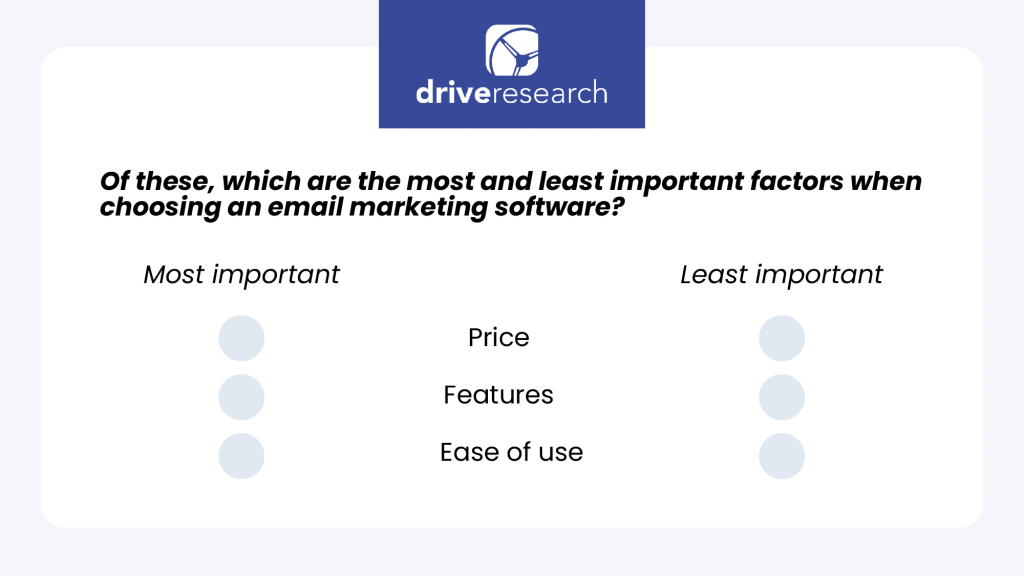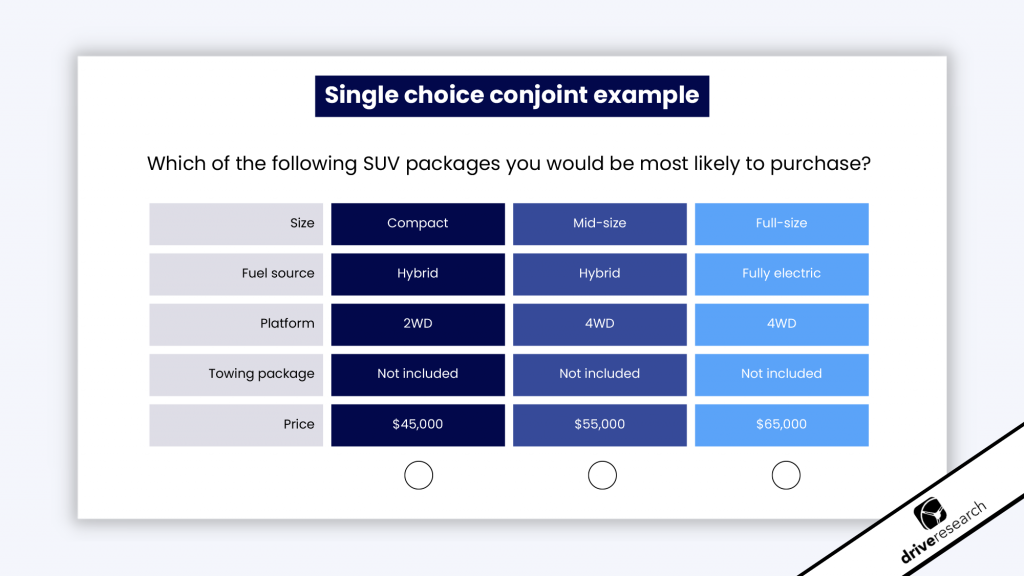
MaxDiff is a form of discrete questioning in market research that asks respondents to choose between the best and worst options out of a list of attributes.
It is commonly used for new product ideas, ad concept testing, packaging designs, and more.
In this post, we’ll discuss MaxDiff analysis in more detail – what it is, when to use it, how to analyze MaxDiff survey results, and more.
What is MaxDiff?
Maximum Differential (MaxDiff) analysis is used in survey research and other forms of experimental design to measure the relative importance or preference of attributes in a product concept.
It is also sometimes called best-worst scaling.
MaxDiff involves respondents being presented with a series of item sets and having them select which items they find the most important and the least important.
In most cases, the process is repeated multiple times with a different collection of attributes each time.
For instance, here is a MaxDiff example question.

After the completion of the MaxDiff, results can be used to determine the relative importance or preference of each item had with respondents. Compared to traditional ranking surveys, MaxDiff is able to better differentiate the gaps in preference, especially in large groups of product features.
It’s a clever technique to save time for the respondent as there is no need to rank a full list of items.
When to Use MaxDiff
MaxDiff analysis is typically used when researchers are looking to understand the relative importance of a large number of attributes or items.
For example, in new product development market research, MaxDiff can be used to determine the attributes or product features that are most important to consumers.
It is a great alternative to the typical 1 to 5 rating scale.
That’s because, compared to the standard rating scale that can be used in survey research, this question type does a more comprehensive job of delineating the differences in perception within a group of items.
Ranking surveys in most cases use a 1 to 5 rating scale on importance-based questions and that suffers primarily from respondent-based issues.
For a large group of respondents, the meaning of a “4” rating could have many different definitions that stem from personal experience.
Whereas, the “most important” and “least important” scale used in a MaxDiff analysis is a consistent scale that has the same meaning for everyone across the entire sample base.
MaxDiff vs Conjoint Analysis
A common question our market research company gets is, “What is the difference between MaxDiff and conjoint analysis?”
Both are excellent advanced analytical tools that provide brands with valuable insights into customer preferences and experiences with their products.
MaxDiff
As we discussed earlier, the primary use for MaxDiff is to determine the relative importance of a set of items.
Respondents will be presented with either a pair or a group of items and are asked to select their most and least preferred option.
Using MaxDiff analysis takes the comparisons made by respondents and calculates the relative importance of each item.
Conjoint analysis
Conversely, conjoint analysis is implemented in survey-based research in order to determine how respondents value different attributes of a product concept. This advanced survey question type can be used to understand how the consumer market values different features within a product.
For instance, Drive Research has used a conjoint choice-based model to determine the ideal product cost.
Additionally, conjoint data can help clients understand which combination of product features is most appealing to their consumer base.
For a deeper dive into this survey analysis technique, I recommend reading Conducting a Conjoint Survey [Ultimate Guide].
What’s the difference?
With MaxDiff, respondents select which attribute is either the most important or least important.
Whereas, in conjoint analysis, respondents are shown two lists of product attributes that make up two different products. Then, they are asked to choose which product they are most likely to purchase.

To summarize, the purpose of MaxDiff analysis is to determine the relative importance of a set of items by comparing groups of items to each other.
Conjoint analysis on the other hand is used to determine how attributes of a product are valued by asking respondents to select hypothetical products that contain a variety of attributes at differing levels.
How to Perform a MaxDiff Analysis
In order to properly implement MaxDiff analysis into your survey-based research, the following steps must be taken. If you’re interested in partnering with a third-party market research company for help, contact Drive Research.
1. Identify which items you want to include in your analysis
Depending on the survey topic this could include product features, brand attributes, or any other item of interest.
2. Sort your items into groups
Your selected items can be sorted into either small groups or pairs.
You must make sure that all items must appear consistently with no one item being shown more times than another. It must also be determined that pairs of items aren’t matched overwhelmingly with each other in order to ensure fair results.
3. Start your data collection
After properly implementing MaxDiff into your survey, open it up to respondents and watch the results roll in.
4. Calculate the MaxDiff score
Once your data collection is complete, proceed to the next step of data analysis where you will be able to estimate the importance of each item in the MaxDiff.
There are multiple different modeling techniques that can be used to calculate these values. After passing this data through a model of your choosing, you will now be able to identify which items are most important/least important to respondents.
For example, once all the data is received for the survey, our market research analysts calculate a MaxDiff score for each factor by taking the percentage of those who rated it “most” and subtracting the percentage of those who rated it “least”.
- If 42% of respondents rated gas mileage as most important when purchasing a hybrid car and 4% rated gas mileage as least important, the MaxDiff score for gas mileage would stand at 38 (42 minus 4).
- Conversely, if 8% rated the hybrid service package as most important when purchasing a hybrid car and 35% rated the service package as least important, the MaxDiff Score for the hybrid service package would stand at -27 (8 minus 35).
After the interpretation of the results, the findings are presented. MaxDiff can be used by businesses for a multitude of purposes not limited to informing pricing decisions, product development, and marketing.
How to Analyze MaxDiff Data?
When concluding a MaxDiff study, there are multiple ways you can go about analyzing the data collected. The method of analysis could differ based on the specific topic of research or the type of market research outcome that is being addressed.
Here are several different methods of analysis that can be used to interpret your MaxDiff survey findings.
Latent Class Analysis (LCA)
This is one of the most common methods of data modeling that is used to identify segments of respondents that share similar preferences for items shown in the MaxDiff.
Segmentation can be done based on single or multiple preferences selected.
Multinomial Logistical Regression
This method can be used to estimate the probabilities of several different outcomes based on categorized dependent variables.
An example research question that could be used for this type of analysis could be “What product will a respondent choose based on their annual spend with the company and the product attributes that are most important to them?”
Conjoint Analysis
MaxDiff results can be taken a step further by implementing a conjoint analysis after the results are collected.
Determining the preference of items during a MaxDiff is a great way to inform a conjoint analysis on which product features should be included in the products presented.
Which is the Best Approach?
In terms of data analysis, there isn’t a single approach that works best for every research outcome.
Depending on the research question, sample size, and type of data collected it is important to find the model that best fits what you’re looking for.
Contact Drive Research to Use MaxDiff Analysis
Drive Research is a full-service market research company specializing in advanced survey analysis techniques. Our team of market research professionals can design, program, field, and analyze several different survey types such as MaxDiff, conjoint analysis, factor analysis, and more.
To learn more about our services or get a quote for conducting a MaxDiff analysis, contact us today.



